I bet if I asked you right now, you could probably remember at least one fable from when you were a kid. I remember my grandmother telling me “The Tortoise and the Hare” when I was seven, frustrated because I couldn’t keep up with my faster classmates in school. That simple story about steady persistence beating natural talent became my personal motto—and it’s probably why I’m writing this guide today instead of giving up on complex projects.
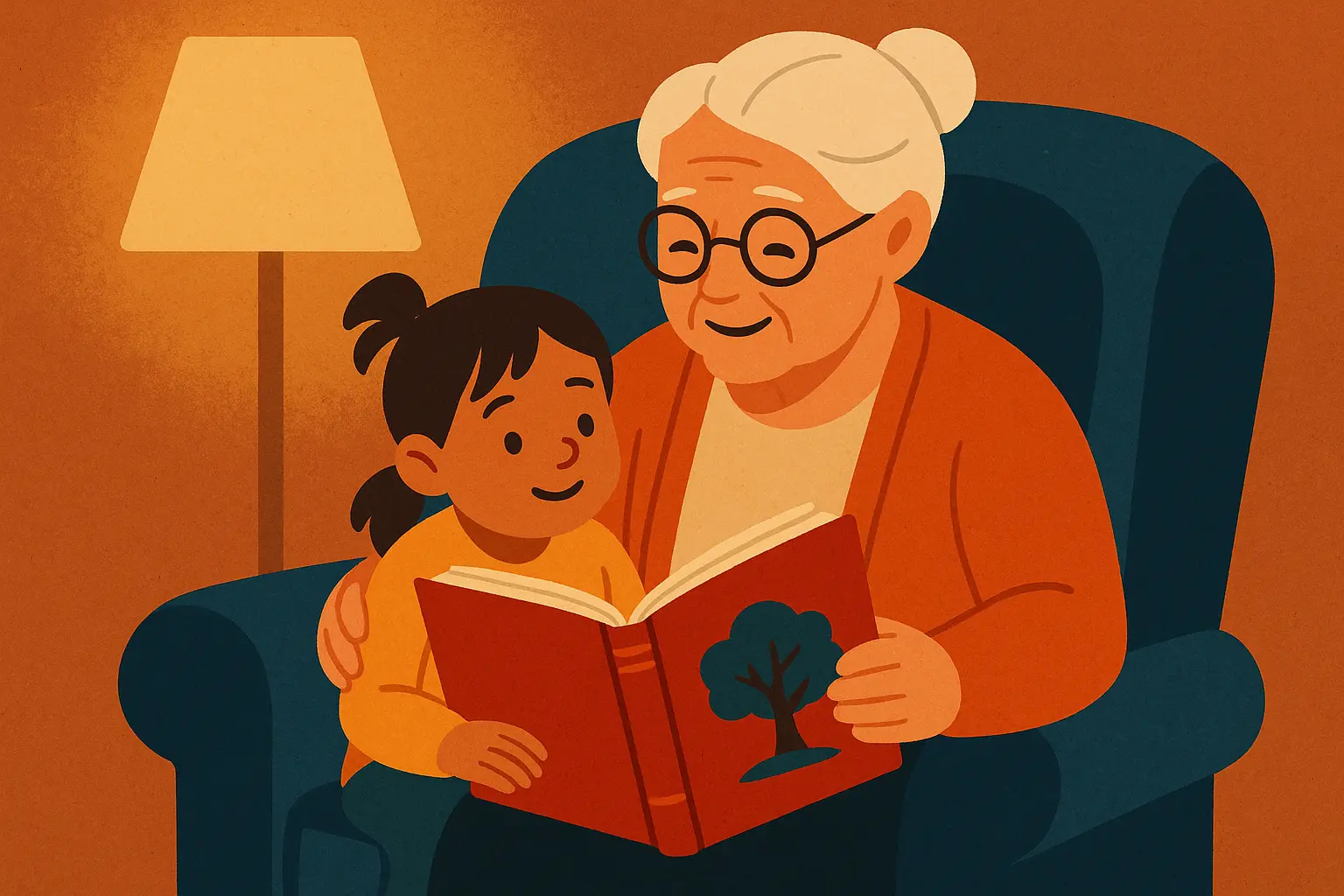
Here’s what’s amazing about these stories—they pack life’s biggest lessons into bite-sized tales that stick with you forever. They’ve been around for thousands of years because they tackle the stuff we all deal with, no matter who we are or where we live. I’ve picked out 25 fables that’ll give you practical wisdom for everything from career moves to relationship drama, money decisions to personal growth.
What Makes a Great Fable: Your Selection Criteria
Picking the right fable isn’t just about finding a story with talking animals—you need to know what makes these short tales so powerful that they’ve stuck around forever.
When I’m choosing a good fable, I ask myself:
- Does it teach something without being preachy?
- Will my 8-year-old and my 80-year-old neighbor both get it?
- Can I actually use this advice next week?
- Is the story interesting enough that I’ll remember it?
- Does it offer a fresh perspective on common problems?
- Is it appropriate for who I’m sharing it with?
Moral Clarity and Relevance
The best fables don’t hit you over the head with their message. You want stories where the lesson feels natural, not like someone’s lecturing you. The moral should be clear enough that you get it, but deep enough that you keep thinking about it later.
Universal Appeal and Accessibility
Great fables work for pretty much everyone. They use simple words and situations we can all relate to—being honest, working hard, treating people well, making smart choices. These stories work whether you’re eight or eighty because they’re about experiences we all share.
Narrative Structure and Engagement
Good stories that keep you interested follow a clear beginning-middle-end pattern with memorable characters (usually animals) that act like real people. The story should be short but complete, giving you maximum impact without wasting words. The best fables don’t have a single unnecessary sentence.
When you’re creating your own moral tales, understanding how to write a story with clear structure becomes essential for maximum impact.
Practical Application
The most valuable fables give you lessons you can actually use tomorrow. Think about how the story’s advice applies to real-life situations in relationships, work, personal growth, and social interactions. Ask yourself: can I use this wisdom next week? That’s the test.
Cultural Significance and Origin
While most people know Aesop’s fables, stories from different cultures offer fresh takes on universal themes. This variety gives you different approaches to the same moral problems. Some work better in certain situations than others.
Age Appropriateness and Complexity
Different fables work for different audiences. Some are perfect for kids with simple lessons, while others contain sophisticated ideas that adults need to think about. The complexity should match who you’re telling the story to and why.
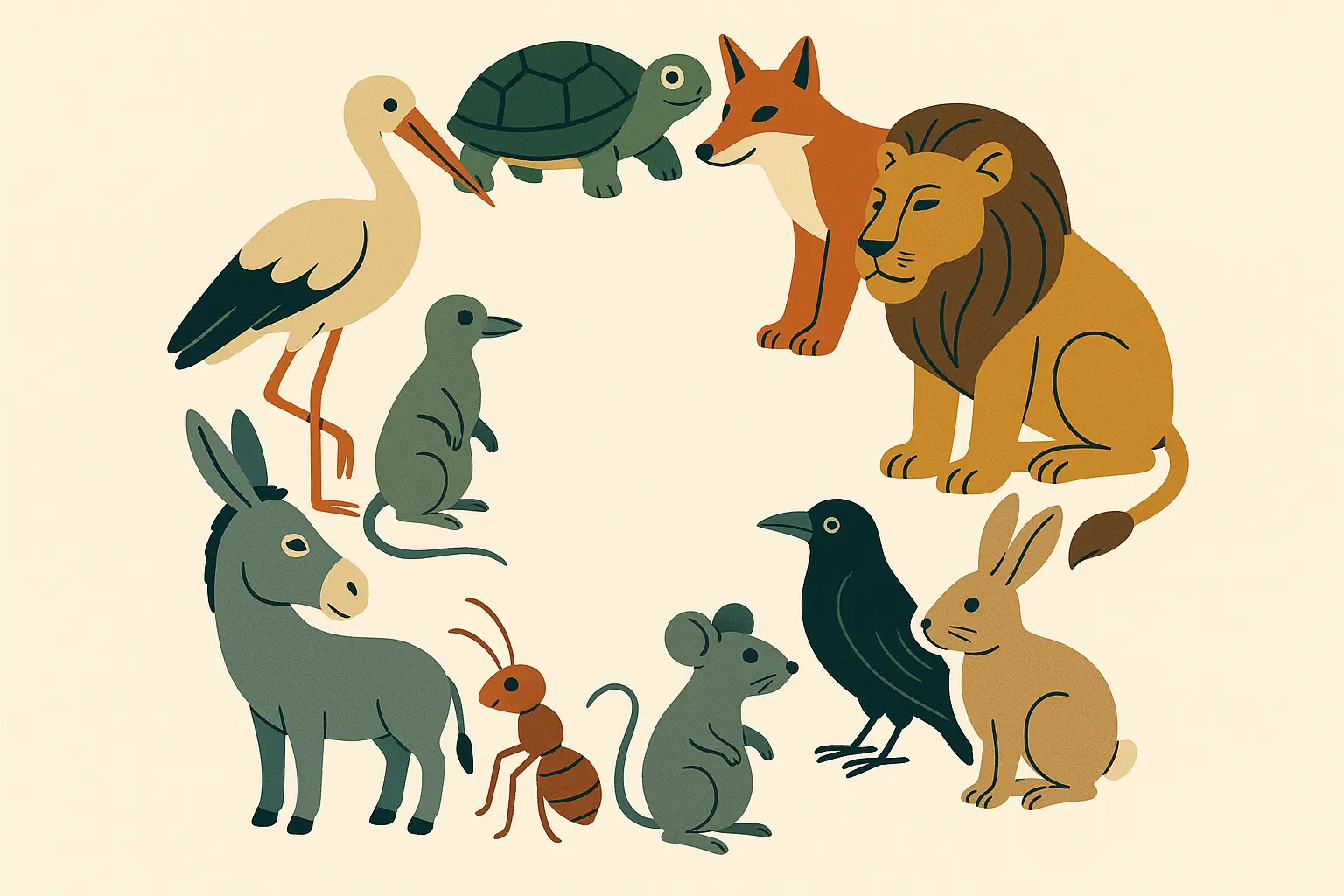
Personal Integrity and Honesty Stories
Your reputation is everything. These five fables show you different sides of honesty and what happens when you mess with it, giving you practical advice for building trust in every part of your life.
1. The Boy Who Cried Wolf
A shepherd boy keeps tricking villagers by yelling “Wolf!” when there isn’t one. When a real wolf shows up, nobody believes him, and he loses his sheep.
You know that coworker who always sends “URGENT” emails about routine stuff? That’s the boy who cried wolf in action. This story shows why credibility matters so much, especially now when everyone’s constantly crying crisis about everything. Your reputation is your most valuable asset—once you lose it, getting it back is nearly impossible.
Here’s how this plays out in real life: Every time you exaggerate a problem at work, every dramatic story you tell friends, every time you call something an emergency when it’s not, you’re spending your credibility. When you actually need help, people remember your track record.
Take my friend Sarah who works in marketing. She constantly labels routine updates as “urgent” and calls regular meetings “emergency sessions.” When her company faced a genuine crisis that needed immediate team response, her emails sat unread because everyone had learned to ignore her dramatic language. Her credibility problem cost precious time during a real emergency.
2. The Tortoise and the Hare
A slow tortoise challenges a fast hare to a race. The cocky hare takes a nap halfway through, letting the steady tortoise win through consistent effort.
This one hits home for me personally. It’s annoying, but the slow-and-steady people really do win most of the time. This story is all about consistency beating natural talent when talent doesn’t work hard.
Here’s what I do now: Whether you’re building a business, learning a skill, or working toward any long-term goal, daily consistent action beats those intense bursts of effort every time. The person who writes 200 words every day will finish their book before the person who writes 2,000 words once a month.
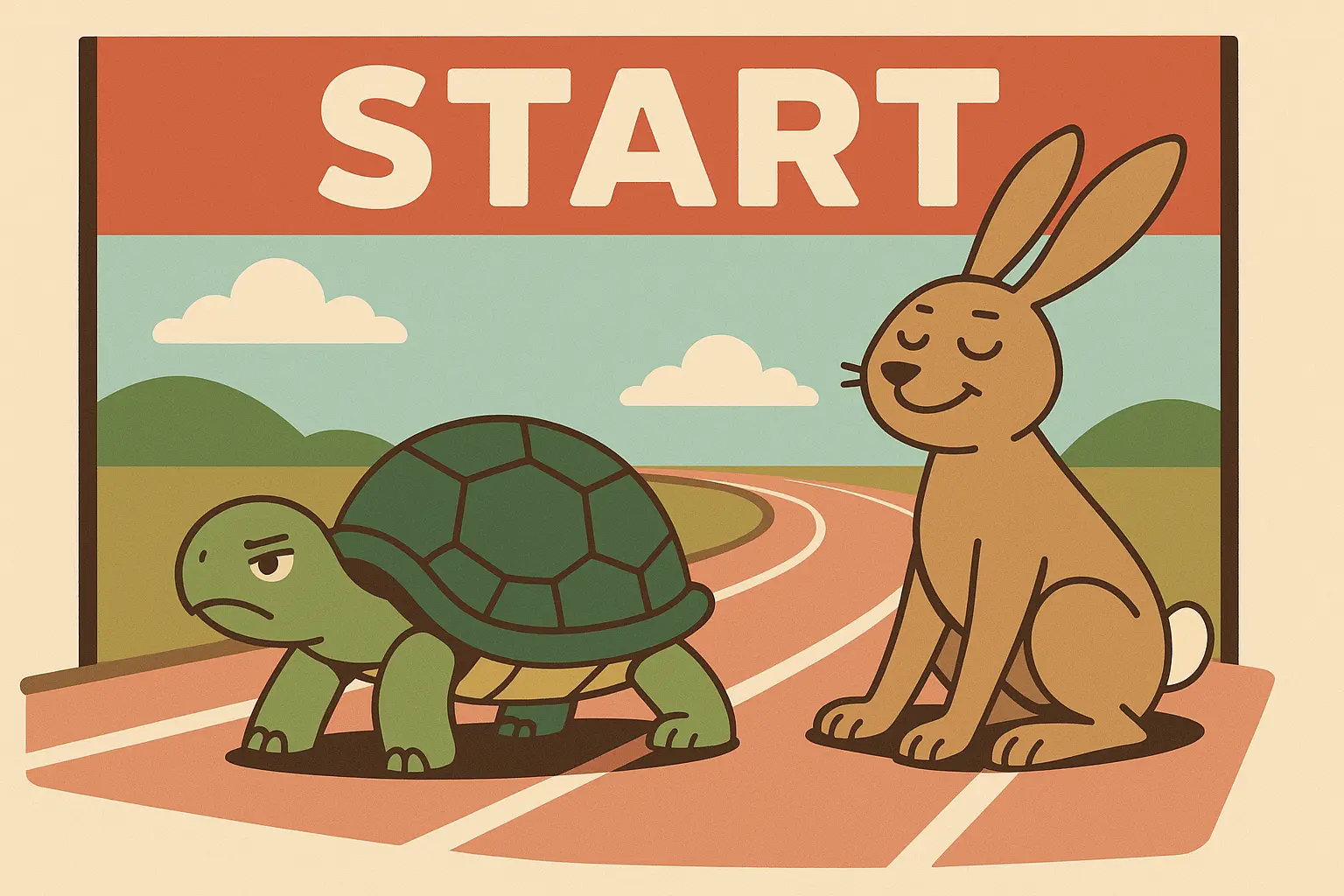
3. The Honest Woodcutter
A woodcutter accidentally drops his axe in a river. A spirit offers him a golden axe, then a silver one, but he honestly says neither is his. Because he’s honest, he gets all three axes.
Look, the magical reward part is fantasy, but the principle is real—honest people build reputations that open doors others don’t even know exist.
Try this yourself: When you find money, return lost items, or admit mistakes at work, you’re building social capital. This reputation becomes valuable currency that creates opportunities others don’t get. I’ve seen people get job offers, business deals, and second chances simply because they had a reputation for honesty.
4. The Emperor’s New Clothes
Con artists convince a vain emperor they’re making invisible clothes that only smart people can see. Everyone pretends to see the clothes until a kid speaks up about the emperor being naked.
This story hits different when you’re in a workplace where everyone’s afraid to question the boss’s bad ideas, or in social situations where you’re supposed to go along with something that’s obviously wrong.
Here’s the thing: How often do you stay quiet when you see problems everyone else is ignoring? Whether it’s a flawed business strategy, toxic team dynamics, or social injustice, someone needs to speak up—and it might as well be you. The kid in the story wasn’t smarter than the adults; he just wasn’t afraid to state the obvious.
5. The Goose That Laid Golden Eggs
A farmer kills his goose that lays golden eggs, hoping to get all the gold at once. He finds nothing inside and loses his steady income forever.
We’ve all been tempted to cash in something good for immediate gratification. This story warns against sacrificing long-term success for short-term gains, which is super relevant in our instant-everything culture.
Real talk: This applies to everything from retirement savings (don’t cash out your 401k early) to business relationships (don’t exploit good clients for quick money) to personal health (don’t sacrifice long-term wellness for immediate pleasures). I learned this lesson the hard way when I left a steady freelance client for what seemed like a better opportunity that lasted three months.
Perseverance and Hard Work Lessons
Success rarely comes from single moments of brilliance—it comes from sustained effort, smart preparation, and creative persistence. These four fables show you different ways that hard work and perseverance create lasting achievement.
6. The Ant and the Grasshopper
While an ant works hard all summer storing food, a grasshopper plays and sings. When winter comes, the grasshopper has nothing while the ant is well-prepared.
My dad used to tell me this story every time I wanted to spend my allowance instead of saving it. I hated it then, but now I get it. This is basically the foundation of personal finance wisdom.
Here’s what this means for you: Emergency funds, retirement contributions, skill development during stable employment—all follow this principle. The time to prepare for winter (job loss, economic downturn, health issues) is during summer (stable income, good health, economic growth). Start building your safety net before you need it.
We’ve all been that grasshopper, scrolling social media instead of doing what we should. The trick is catching yourself and switching to ant mode before it’s too late.
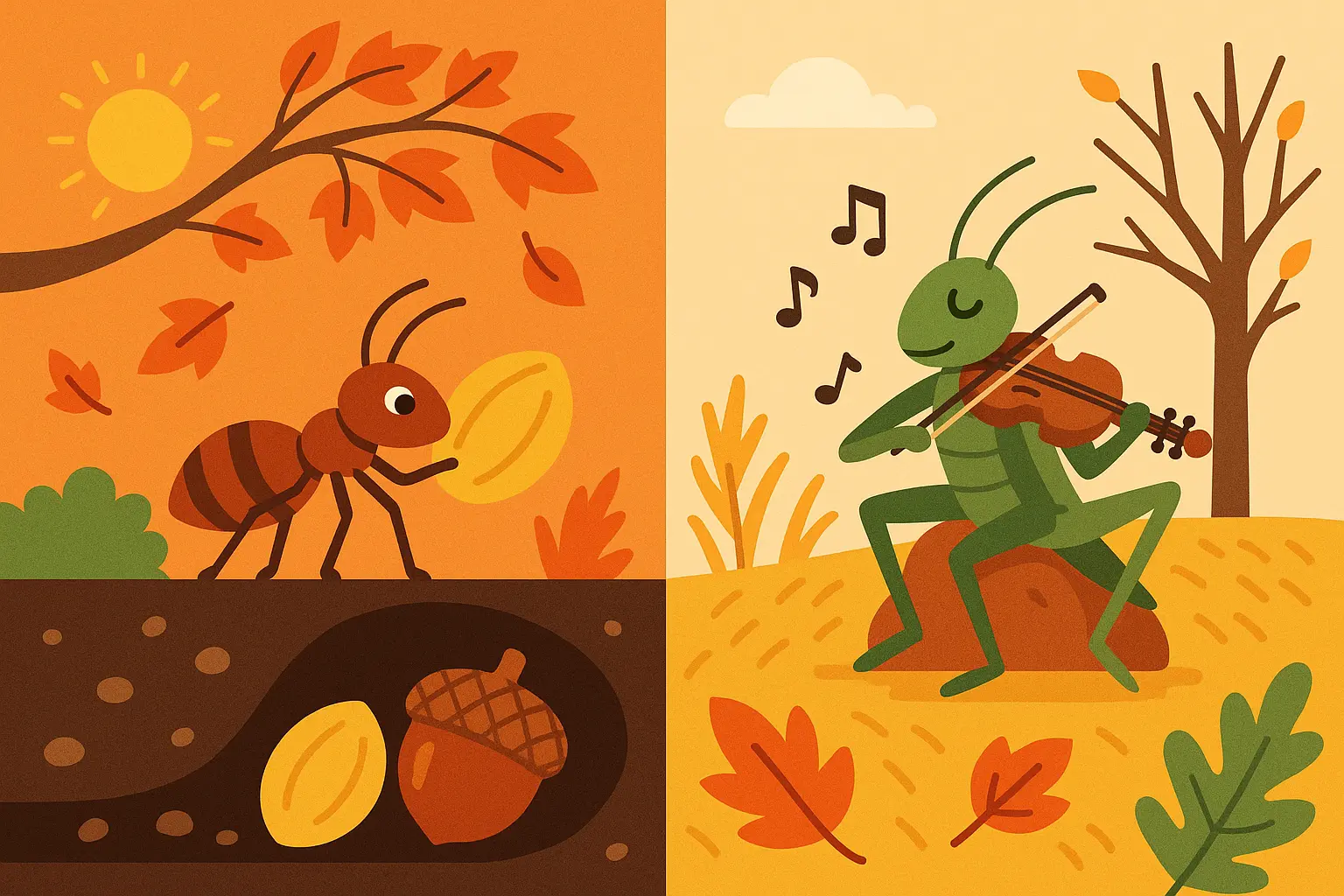
7. The Little Engine That Could
A small engine succeeds in pulling a heavy train over a mountain by maintaining a positive attitude and repeating “I think I can.”
Look, positive thinking alone isn’t magic, but the right mindset definitely helps you keep going when others give up. This story shows how your internal voice either fuels persistence or justifies quitting.
Try this approach: When facing difficult projects, challenging relationships, or personal goals, pay attention to the voice in your head. “I think I can” becomes “I know I will” through repeated action. Your internal dialogue shapes your actions more than you realize.
8. The Bundle of Sticks
A father shows his sons that individual sticks break easily, but bound together they’re unbreakable, teaching that unity creates strength.
This one’s huge for team building, family unity, and understanding why collective action works better than going it alone. Individual effort has limits—collaborative effort multiplies strength.
Here’s how to use this: Whether you’re building a business, raising kids, or working toward social change, this principle applies. Successful movements, companies, and families work because individual strengths combine rather than compete. Your weaknesses become irrelevant when others’ strengths fill the gaps.
9. The Crow and the Pitcher
A thirsty crow drops pebbles into a pitcher to raise the water level high enough to drink, showing creative problem-solving when facing resource constraints.
This story teaches resourcefulness and innovation when you’re facing seemingly impossible obstacles. Sometimes the solution isn’t working harder—it’s working smarter.
Think about your current challenges: When you lack resources (time, money, connections, skills), creativity becomes your most valuable asset. The crow couldn’t break the pitcher or tip it over, so it found a third option. What third options exist in your situation?
My friend Mike used this principle when he couldn’t afford expensive marketing software for his startup. Instead of trying to compete with big budgets, he built relationships with micro-influencers who charged less but had highly engaged audiences. He accumulated small, strategic partnerships that eventually gave him the marketing reach he needed.
Wisdom and Decision-Making Tales
Good decision-making requires both emotional intelligence and rational thinking. These four fables help you spot common thinking traps while developing better judgment about relationships, opportunities, and personal choices.
10. The Fox and the Grapes
A fox can’t reach high grapes, so he declares them sour and walks away, convincing himself he didn’t want them anyway.
We all do this when we don’t get what we want—we lie to ourselves when we’re disappointed. This story helps you recognize when you’re protecting your ego instead of being honest about what happened.
Be honest with yourself: When you don’t get the job, the relationship, or the opportunity you wanted, notice your internal story. Are you genuinely relieved, or are you just protecting your feelings by deciding it wasn’t worth having? Honest self-assessment prevents you from missing similar opportunities in the future.
11. The Town Mouse and the Country Mouse
Two mice experience each other’s lifestyles, learning that simple security often beats luxury with danger. Each discovers their own environment suits their values better.
This story helps with career choices, lifestyle decisions, and understanding what you actually value versus what you think you should want.
Ask yourself this: Before making major life changes (career moves, relocations, relationship decisions), honestly assess what you value most. Security or excitement? Simplicity or sophistication? Community or opportunity? Neither choice is wrong, but the wrong choice for you creates misery.
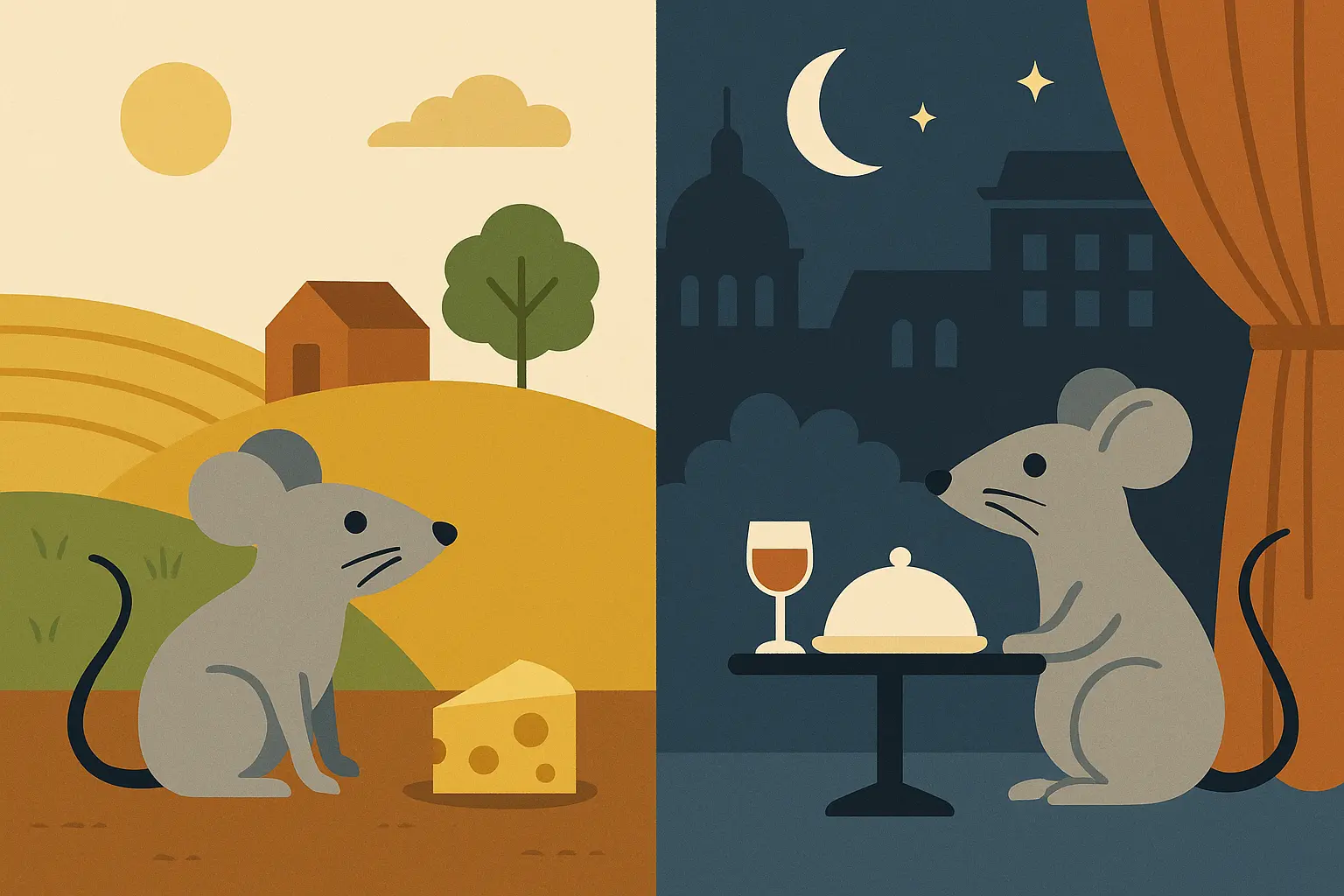
12. The Lion and the Mouse
A tiny mouse saves a mighty lion who had previously spared the mouse’s life, proving that no act of kindness is too small and help can come from unexpected sources.
This story changed how I think about networking and relationship building. You never know who might be in a position to help you later.
Here’s what I learned: Treat everyone with respect and kindness, from the CEO to the janitor. The intern you mentor today might be your boss tomorrow. The struggling colleague you help might recommend you for your dream job. Kindness is an investment with unpredictable but valuable returns.
13. The Farmer and the Viper
A farmer saves a freezing viper, only to be bitten when it revives, teaching that kindness to inherently harmful people can be dangerous.
This one’s tough but important for recognizing toxic relationships and understanding when compassion should have boundaries. Some people consistently harm others despite receiving help and kindness.
Trust me on this: Whether it’s an abusive partner, a manipulative friend, or a toxic colleague, this fable reminds you that your safety and well-being matter more than being endlessly compassionate to people who exploit your kindness. It’s not about being mean—it’s about being smart.
Relationships and Social Dynamics Stories
Human relationships require understanding power dynamics, communication styles, and emotional intelligence. These four fables offer practical guidance for navigating social situations with wisdom and grace.
14. The North Wind and the Sun
The wind and sun compete to remove a traveler’s coat. The wind’s force fails, but the sun’s gentle warmth succeeds in making the traveler voluntarily remove his coat.
This story shows that gentle persuasion often works better than force in negotiations, parenting, and leadership. Trying to force people usually backfires—invitation creates cooperation.
Try this approach: Whether you’re trying to change someone’s mind, motivate a team, or resolve a conflict, aggressive tactics usually make things worse. Instead of demanding compliance, create conditions where people want to cooperate. Ask questions instead of making demands. Offer benefits instead of threats.
15. The Dog and His Reflection
A dog carrying a bone sees his reflection in water and, wanting the other dog’s bone too, barks and loses his own bone in the process.
Social media makes this story super relevant. It’s easy to see others’ highlight reels and want their lives, jobs, or relationships, making you dissatisfied with genuinely good situations.
Here’s what helps: Before chasing what others have, appreciate what you already possess—you might lose it in the pursuit. That constant comparison can make you throw away something good while chasing something that might not even be real.
16. The Ugly Duckling
A young swan, raised among ducks, feels ugly and different until discovering his true identity as a beautiful swan and finding his real community.
If you consistently feel out of place, maybe you’re not the problem—maybe you’re just in the wrong environment. The qualities that make you weird in one group might make you valuable in another.
Think about your situation: Sometimes you’re not defective; you’re just surrounded by the wrong people. Find your swans. This doesn’t mean there’s anything wrong with the ducks—you’re just different species.
Similar themes of finding your place appear in many folktale story examples that explore identity and belonging across cultures.
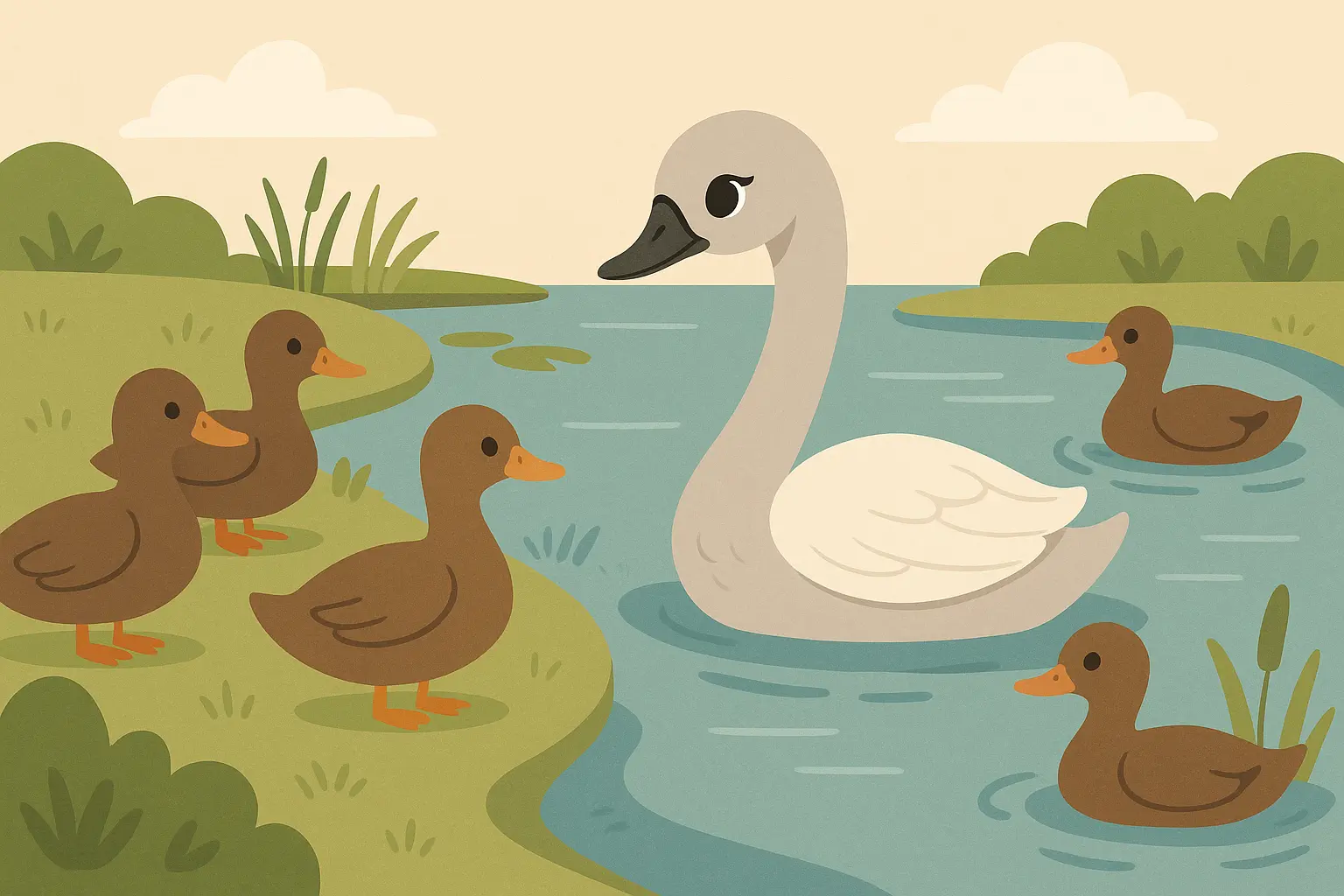
17. The Golden Rule Fable
Various animals learn to treat others as they wish to be treated, creating harmony in their community through mutual respect and consideration.
This is the foundation for ethical behavior in all relationships, from family dynamics to international diplomacy. It’s the most universally recognized moral principle across cultures and religions.
Before reacting to difficult people: Ask yourself how you’d want to be treated in their situation. This doesn’t mean being a doormat—it means responding with the same respect, honesty, and fairness you’d want to receive. This principle transforms conflicts into conversations and enemies into allies.
Leadership and Responsibility Fables
Leadership requires balancing competing interests, maintaining credibility, and making decisions with incomplete information. These four fables address the complex challenges that come with authority and responsibility.
18. The Shepherd Boy and the Wolf (Leadership Version)
A young leader learns that false alarms destroy credibility, leaving communities vulnerable when real crises occur. His team stops responding to his warnings after too many false emergencies.
Look, here’s the thing about credibility as a leader—every “urgent” email, every “emergency” meeting, every “critical” deadline you declare spends your credibility currency. When you actually face a real crisis, your team’s response depends on your track record.
Here’s what I learned the hard way: Reserve crisis language for actual crises, and your people will respond when it matters most. I once worked for a manager who treated everything like a five-alarm fire. When we had a genuine client emergency that could cost us the account, half the team didn’t even read his email because we’d learned to tune him out.
19. The Lion’s Share
A lion, fox, and ass hunt together, but the lion claims the largest portion unfairly, teaching about power dynamics and fairness in resource distribution.
Just because you can take more doesn’t mean you should. This applies to profit-sharing, team recognition, and how you distribute resources in organizations.
Ask yourself this: When your team succeeds, how do you distribute credit and rewards? Leaders who hoard recognition and resources create resentment and kill future cooperation. Fair distribution builds loyalty and encourages continued high performance.
20. The Blind Men and the Elephant
Several blind men touch different parts of an elephant and argue about what it is, each convinced their limited perspective represents complete truth.
This one’s essential for understanding that complex problems require multiple viewpoints for complete understanding. Before making major decisions, actively seek different perspectives.
Here’s how this works: The marketing team sees customer acquisition costs while customer service sees retention issues. Finance sees budget constraints while operations sees efficiency needs. Great leaders pull these different viewpoints together instead of picking sides.
When CEO Jennifer faced declining sales, she initially blamed the marketing team. But applying this fable’s wisdom, she gathered perspectives from customer service (product quality issues), operations (supply chain delays), and finance (pricing problems). The real issue wasn’t marketing—it was a complex combination requiring coordinated solutions across all departments.
21. The Eagle and the Arrow
An eagle, shot by an arrow made from its own feathers, realizes it was destroyed by something it had created.
This story warns about unintended consequences of your actions and decisions. The policies you create, the people you hire, the systems you build can eventually work against you.
Think long-term: Consider the implications of your decisions beyond immediate results. The cost-cutting measures that boost short-term profits might destroy long-term competitiveness. The aggressive competitor you train might eventually start their own company and take your clients.

Self-Improvement and Growth Narratives
Personal growth requires honest self-assessment, adaptability, and the courage to change. These four fables guide you through the challenges of becoming your best self while staying true to your authentic nature.
22. The Oak and the Reed
A mighty oak mocks a flexible reed, but when storms come, the oak breaks while the reed bends and survives.
Sometimes flexibility is stronger than rigidity. This story teaches adaptability and resilience in changing circumstances, which is crucial for career pivots and personal growth.
Here’s the reality: Industries change, relationships evolve, life circumstances shift. The people who adapt survive and thrive while those who resist change often get left behind. This doesn’t mean abandoning your core values—it means adjusting your methods while maintaining your principles.
23. The Peacock and the Crane
A peacock mocks a crane’s plain appearance, but the crane points out that while the peacock is beautiful, the crane can fly.
Stop comparing your weaknesses to others’ strengths. Everyone has different abilities and limitations, and that’s actually a good thing.
Focus on this instead: The colleague who’s better at presentations might struggle with detailed analysis. The friend who’s more attractive might lack your emotional intelligence. Develop your unique abilities rather than envying others’ gifts.
Understanding different character strengths is essential when exploring story theme examples that showcase diverse human qualities and perspectives.
24. The Miller, His Son, and the Donkey
A miller and his son try to please everyone’s opinions about how to transport their donkey, ultimately pleasing no one and looking foolish in the process.
You’ll drive yourself crazy trying to satisfy everyone’s expectations and opinions. This story teaches the impossibility and futility of trying to please everyone.
Here’s what I do now: Make decisions based on your values and circumstances, not on what others think you should do. The people whose opinions truly matter will respect your authentic choices even when they disagree. Everyone else’s opinion doesn’t actually matter.
25. The Phoenix Rising
A phoenix burns itself to ashes and rises renewed, teaching that sometimes destruction is necessary for rebirth and transformation.
Sometimes you must let go of who you were to become who you’re meant to be. This applies to career changes, relationship endings, and personal transformation processes.
Think about major life changes: Leaving a stable job to start a business, ending a comfortable but unfulfilling relationship, or moving away from family to pursue opportunities—these decisions involve loss but enable growth. The phoenix doesn’t rise despite the burning; it rises because of it.

How Each Fable Measures Against Key Criteria
Understanding how each fable performs against our selection criteria helps you choose the right stories for your specific needs and audience. Here’s how the 25 fables stack up:
Best for Universal Appeal: The Golden Rule works everywhere, the Lion and Mouse resonates globally because kindness is universally valued, and the Ugly Duckling addresses the universal experience of feeling different.
Clearest Moral Messages: The Boy Who Cried Wolf delivers an unambiguous lesson about credibility. The Tortoise and the Hare clearly shows that consistency beats talent without discipline. The Bundle of Sticks provides a crystal-clear message about unity creating strength.
Most Practical Application: The Ant and the Grasshopper directly applies to financial planning and life management. The North Wind and the Sun immediately improves your negotiation skills. The Miller, His Son, and the Donkey instantly helps with decision-making and authenticity.
Best for All Ages: The Tortoise and the Hare works for children learning about effort while offering adults insights about consistency versus talent. The Bundle of Sticks teaches kids about cooperation while showing adults the power of collective action.
Most Complex and Adult-Focused: The Blind Men and the Elephant requires understanding of perspective and collaborative thinking. The Eagle and the Arrow needs strategic thinking about unintended consequences. The Phoenix Rising demands contemplation about transformation and renewal.
Different situations call for different fables:
- Workplace Training: North Wind/Sun, Blind Men/Elephant, Lion’s Share address common management challenges
- Child Development: Tortoise/Hare, Bundle of Sticks, Golden Rule offer simple morals with lasting impact
- Personal Finance: Ant/Grasshopper, Goose/Golden Eggs, Dog/Reflection provide direct financial wisdom
- Relationship Building: Lion/Mouse, Golden Rule, Ugly Duckling foster empathy and connection
- Crisis Management: Boy Who Cried Wolf, Oak/Reed, Phoenix Rising teach preparation and adaptation
- Decision Making: Fox/Grapes, Miller/Son/Donkey, Town/Country Mouse help recognize biases and priorities
Bringing Fable Wisdom Into Modern Storytelling
The timeless appeal of fables lies in their ability to compress profound wisdom into brief, memorable narratives. This technique works perfectly for modern digital storytelling, where you need to capture attention and deliver meaningful messages efficiently.
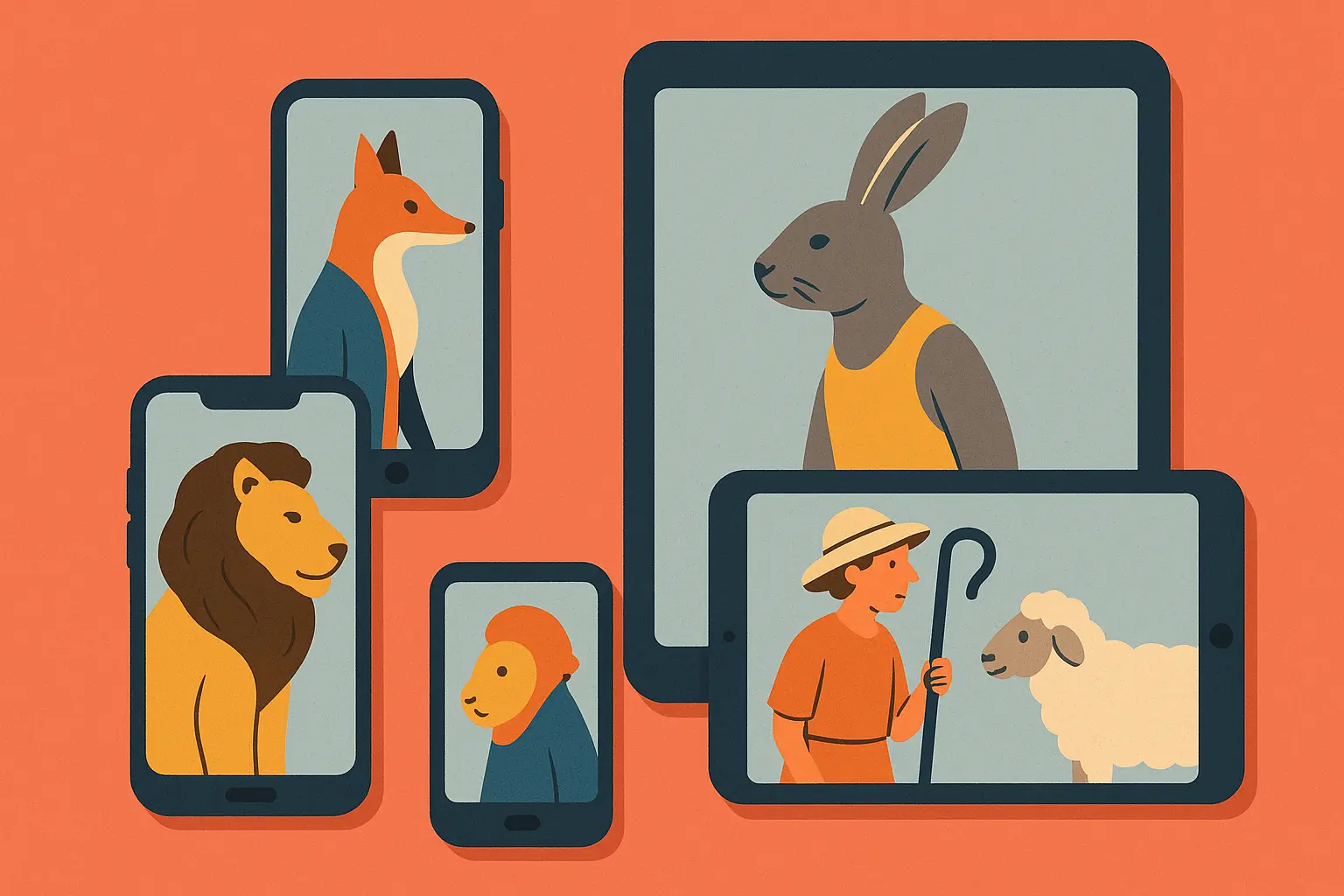
Story Development Principles
Whether you’re creating modern fables or drawing inspiration from traditional ones, effective storytelling requires developing compelling characters with clear human traits, creating moral dilemmas that resonate with today’s audiences, and structuring narratives that deliver clear lessons without being preachy.
Modern fable-inspired stories work particularly well for corporate training materials that teach leadership and teamwork, social media content that delivers bite-sized wisdom, educational resources that present contemporary versions of classic morals, and personal development content with the memorability of traditional fables.
For those interested in creating original moral tales, exploring short story examples can provide inspiration for structure and character development.
Creative Applications
Today’s storytellers can create workplace fables that address modern challenges—the employee who takes credit for others’ work (a modern “Lion’s Share”), the team member who constantly cries crisis (updated “Boy Who Cried Wolf”), or the manager who uses force instead of influence (contemporary “North Wind and Sun”).
These updated versions maintain the moral clarity and practical application of traditional fables while addressing current workplace dynamics, relationship challenges, and personal growth opportunities.
Precision in Modern Storytelling
The careful word selection required in fables translates directly to modern content creation. Maximum impact with minimal words becomes essential for social media storytelling, clear moral messaging without heavy-handed preaching improves all content, and engaging narratives that teach while they entertain create lasting impact.
Writers looking to develop their own moral tales can benefit from understanding how to write a short short story techniques that maximize impact in minimal space.
Final Thoughts
Look, I’m not saying these old stories will solve all your problems. But they’ve helped me make better decisions, and maybe they’ll help you too. These 25 fables represent thousands of years of human wisdom packed into memorable, actionable stories. They’ve survived because they address fundamental challenges we all face—building trust, making difficult decisions, navigating relationships, leading others, and growing as individuals.
The real power of these stories isn’t just in reading them, but in applying their lessons consistently in your daily life. The next time you’re tempted to exaggerate a problem at work, remember the Boy Who Cried Wolf. When you’re frustrated by slow progress toward a goal, think of the Tortoise and the Hare. When you’re trying to change someone’s mind, recall the North Wind and the Sun.
These fables work because they don’t just tell you what to do—they show you why it matters through memorable stories that stick in your mind. They transform abstract moral concepts into concrete, relatable situations you can remember and apply when you need them most.
Parents seeking to share these timeless lessons will find that many of these stories work perfectly as bedtime stories for kids that teach valuable morals while entertaining young minds.
Whether you’re a parent teaching children, a leader guiding teams, or simply someone seeking wisdom for your own journey, these 25 fables offer practical guidance that has stood the test of time. The lessons they contain aren’t just ancient wisdom—they’re timeless truths that remain as relevant today as they were centuries ago.
Trust me on this one—I learned it the hard way. These simple stories really do work.



Add comment